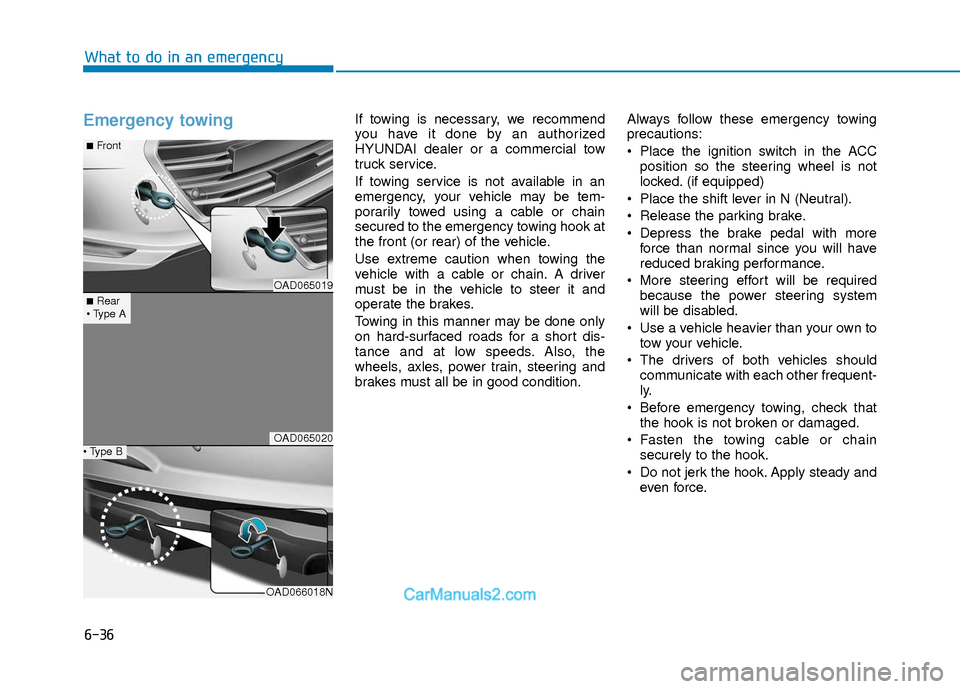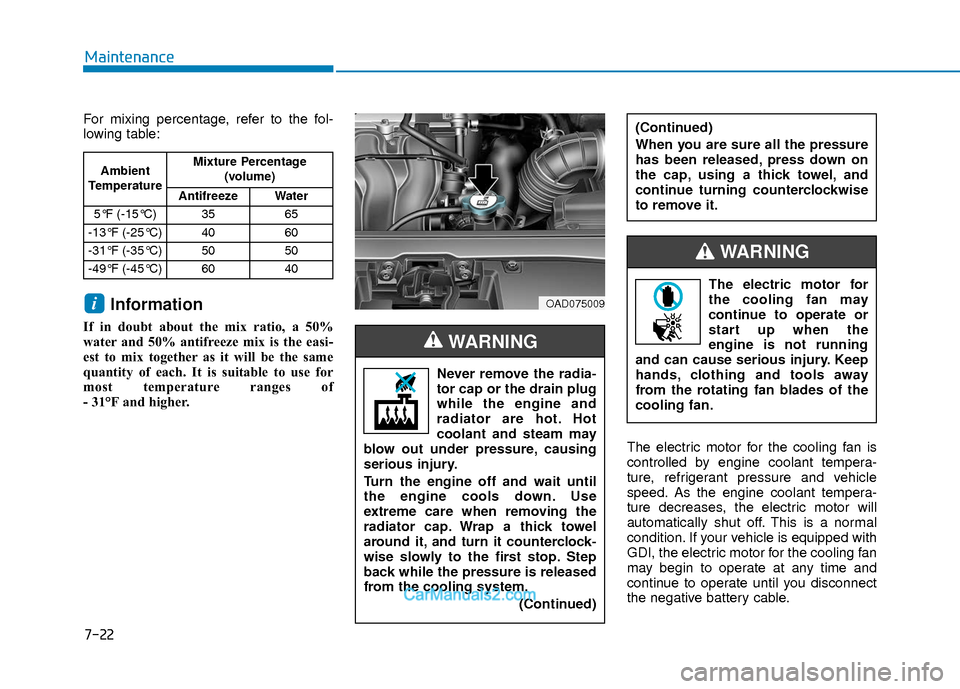2018 Hyundai Elantra tow
[x] Cancel search: towPage 417 of 526

6-36
What to do in an emergency
Emergency towing If towing is necessary, we recommend
you have it done by an authorized
HYUNDAI dealer or a commercial tow
truck service.
If towing service is not available in an
emergency, your vehicle may be tem-
porarily towed using a cable or chain
secured to the emergency towing hook at
the front (or rear) of the vehicle.
Use extreme caution when towing the
vehicle with a cable or chain. A driver
must be in the vehicle to steer it and
operate the brakes.
Towing in this manner may be done only
on hard-surfaced roads for a short dis-
tance and at low speeds. Also, the
wheels, axles, power train, steering and
brakes must all be in good condition.Always follow these emergency towing
precautions:
Place the ignition switch in the ACC
position so the steering wheel is not
locked. (if equipped)
Place the shift lever in N (Neutral).
Release the parking brake.
Depress the brake pedal with more force than normal since you will have
reduced braking performance.
More steering effort will be required because the power steering system
will be disabled.
Use a vehicle heavier than your own to tow your vehicle.
The drivers of both vehicles should communicate with each other frequent-
ly.
Before emergency towing, check that the hook is not broken or damaged.
Fasten the towing cable or chain securely to the hook.
Do not jerk the hook. Apply steady and even force.
OAD065019
OAD065020
OAD066018N
■Rear
■Front
Page 418 of 526

6-37
What to do in an emergency
6
Use a towing cable or chain less than16 feet (5 m) long. Attach a white or red
cloth (about 12 inch (30 cm) wide) in
the middle of the cable or chain for
easy visibility.
Drive carefully so the towing cable or chain remains tight during towing.
Before towing, check the automatic transaxle/dual clutch transmission for
fluid leaks under your vehicle. If the
automatic transaxle/dual clutch trans-
mission fluid is leaking, flatbed equip-
ment or a towing dolly must be used.
Tie-down hook
ODH063025
To avoid damage to your vehicle
and vehicle components when tow-
ing:
Always pull straight ahead when
using the towing hooks. Do not
pull from the side or at a vertical
angle.
Do not use the towing hooks to
pull a vehicle out of mud, sand or
other conditions from which the
vehicle cannot be driven out under
its own power.
Limit the vehicle speed to
10 mph (15 km/h) and drive less
than 1 mile (1.5 km) when towing
to avoid serious damage to the
automatic transaxle/dual clutch
transmission.
CAUTION
OLMB033091
Do not use the tie-down hook(s) for
towing purposes. If the tie-down
hook(s) are used for towing, the tie-
down hook(s) or bumper will be
damaged and this could lead to
serious injury.
WARNING
Page 429 of 526

7-11
7
MaintenanceSevere Driving Conditions
A - Repeatedly driving short distances of less than 5 miles (8 km) in normal temperature or less than 10 miles (16 km)
in freezing temperature
B - Extensive engine idling or low speed driving for long dis- tances
C - Driving on rough, dusty, muddy, unpaved, graveled or salt- spread roads
D - Driving in areas using salt or other corrosive materials or in very cold weather E - Driving in sandy areas
F - Driving in heavy traffic area over 90°F (32°C)
G- Driving on uphill, downhill, or mountain road
H - Towing a Trailer, or using a camper, or roof rack
I - Driving as a patrol car, taxi, other commercial use or vehicle
towing
J - Driving over 106 mph (170 km/h)
K - Frequently driving in stop-and-go conditions
MAINTENANCE ITEMMAINTENANCE OPERATIONMAINTENANCE INTERVALSDRIVING
CONDITION
Parking brakeIMore frequentlyC, D, G, H
Steering gear box, linkage & boots/
lower arm ball joint, upper arm ball
joint
IMore frequentlyC, D, E, F, G, H, I
Drive shafts and bootsIEvery 3,750 miles or 6 monthsC, D, E, F, G, H, I
Climate control air filter
(for evaporator and blower unit)RMore frequentlyC, E
Page 434 of 526

7-16
Maintenance
Severe Driving Conditions
A - Repeatedly driving short distances of less than 5 miles (8 km) in normal temperature or less than 10 miles (16 km)
in freezing temperature
B - Extensive engine idling or low speed driving for long dis- tances
C - Driving on rough, dusty, muddy, unpaved, graveled or salt- spread roads
D - Driving in areas using salt or other corrosive materials or in very cold weather E - Driving in sandy areas
F - Driving in heavy traffic area over 90°F (32°C)
G- Driving on uphill, downhill, or mountain road
H - Towing a Trailer, or using a camper, or roof rack
I - Driving as a patrol car, taxi, other commercial use or vehicle
towing
J - Driving over 106 mph (170 km/h)
K - Frequently driving in stop-and-go conditions
MAINTENANCE ITEMMAINTENANCE OPERATIONMAINTENANCE INTERVALSDRIVING
CONDITION
Parking brakeIMore frequentlyC, D, G, H
Steering gear box, linkage & boots/
lower arm ball joint, upper arm ball
joint
IMore frequentlyC, D, E, F, G, H, I
Drive shafts and bootsIEvery 3,000 miles or 6 monthsC, D, E, F, G, H, I
Climate control air filter
(for evaporator and blower unit)RMore frequentlyC, E
Page 440 of 526

7-22
Maintenance
For mixing percentage, refer to the fol-
lowing table:
Information
If in doubt about the mix ratio, a 50%
water and 50% antifreeze mix is the easi-
est to mix together as it will be the same
quantity of each. It is suitable to use for
most temperature ranges of
- 31°F and higher.The electric motor for the cooling fan is
controlled by engine coolant tempera-
ture, refrigerant pressure and vehicle
speed. As the engine coolant tempera-
ture decreases, the electric motor will
automatically shut off. This is a normal
condition. If your vehicle is equipped with
GDI, the electric motor for the cooling fan
may begin to operate at any time and
continue to operate until you disconnect
the negative battery cable.
i
Ambient
Temperature Mixture Percentage
(volume)
Antifreeze Water
5°F (-15°C) 35 65
-13°F (-25°C) 40 60
-31°F (-35°C) 50 50
-49°F (-45°C) 60 40
Never remove the radia-
tor cap or the drain plug
while the engine and
radiator are hot. Hot
coolant and steam may
blow out under pressure, causing
serious injury.
Turn the engine off and wait until
the engine cools down. Use
extreme care when removing the
radiator cap. Wrap a thick towel
around it, and turn it counterclock-
wise slowly to the first stop. Step
back while the pressure is released
from the cooling system.
(Continued)
WARNING
(Continued)
When you are sure all the pressure
has been released, press down on
the cap, using a thick towel, and
continue turning counterclockwise
to remove it.
OAD075009
The electric motor for
the cooling fan may
continue to operate or
start up when the
engine is not running
and can cause serious injury. Keep
hands, clothing and tools away
from the rotating fan blades of the
cooling fan.
WARNING
Page 441 of 526

7-23
7
Maintenance
B
BR
RA
A K
KE
E/
/C
C L
LU
U T
TC
CH
H
F
F L
LU
U I
ID
D
Changing Engine Coolant
Have coolant changed by an authorized
HYUNDAI dealer according to the
Maintenance Schedule at the beginning
of this chapter.
To prevent damage to engine parts,
put a thick towel around the radiator
cap before refilling the coolant to pre-
vent the coolant from overflowing into
engine parts, such as the generator.
Checking the Brake/Clutch
Fluid Level
Check the fluid level in the reservoir peri-
odically. The fluid level should be
between MAX and MIN marks on the
side of the reservoir.
Before removing the reservoir cap and
adding brake/clutch fluid, clean the area
around the reservoir cap thoroughly to
prevent brake/clutch fluid contamination.
If the level is low, add the specified
brake/clutch fluid to the MAX level. The
level will fall with accumulated mileage.
This is a normal condition associated
with the wear of the brake/clutch linings.
If the fluid level is excessively low, have
the brake/clutch system checked by an
authorized HYUNDAI dealer.
NOTICE
Do not use engine coolant or
antifreeze in the washer fluid reser-
voir.
Engine coolant can severely
obscure visibility when sprayed on
the windshield and may cause loss
of vehicle control resulting in an
accident.
Engine coolant may also cause
damage to paint and body trim.
WARNING
If the brake system requires fre-
quent additions of fluid this could
indicate a leak in the brake system.
Have the vehicle inspected by an
authorized HYUNDAI dealer.
WARNING
Do not allow brake/clutch fluid to
come in contact with your eyes. If
brake/clutch fluid comes in contact
with your eyes, flush your eyes with
clean water for at least 15 minutes
and get immediate medical atten-
tion.
WARNING
OAD075010
Page 525 of 526

I-8
Steering Wheel ................................................................3-18Electric Power Steering (EPS) ...................................3-18
Horn ........................................................................\
....3-19
Tilt Steering/Telescope Steering.................................3-19
Storage Compartment ...................................................3-135 Center Console Storage ............................................3-136
Glove Box ................................................................3-136
Multi box ..................................................................3-137
Sliding Armrest ........................................................3-136
Sunglass Holder........................................................3-137
Sunroof........................................................................\
....3-41 Resetting the sunroof..................................................3-44
Sliding the sunroof .....................................................3-42
Sunroof opening and closing......................................3-42
Sunshade.....................................................................3-4\
3
Tilting the sunroof ......................................................3-43
Theft-Alarm System .......................................................3-15
Tire Pressure Monitoring System (TPMS) .......................6-7 Changing a Tire with TPMS ......................................6-11
Check Tire Pressure......................................................6-7
Low Tire Pressure LCD Display with Position Indicator ......................................................6-9
Low Tire Pressure Telltale............................................6-9
Tire Pressure Monitoring System.................................6-8
TPMS Malfunction Indicator .....................................6-10 Tire Specification and Pressure Label ............................8-11
Tires and Wheels .....................................................7-33, 8-5
All Season Tires .........................................................7-46
Check Tire Inflation Pressure .....................................7-35
Low Aspect Ratio Tires ..............................................7-47
Radial-Ply Tires ..........................................................7-46
Recommended Cold Tire Inflation Pressures.............7-34
Snow Tires ..................................................................7-46
Summer Tires .............................................................7-46
Tire Care .....................................................................7-3\
3
Tire Maintenance ........................................................7-39
Tire Replacement........................................................7\
-37
Tire Rotation...............................................................7-36
Tire Sidewall Labeling ...............................................7-39
Tire Terminology and Definitions ..............................7-43
Tire Traction ...............................................................7-38
Wheel Alignment and Tire Balance ...........................7-37
Wheel Replacement....................................................7-38
Towing ........................................................................\
....6-34 Emergency towing......................................................6-36
Removable Towing Hook...........................................6-35
Tie-down hook............................................................\
6-37
Towing service ...........................................................6-34
Trailer Towing.................................................................5-98
Trip Computer .................................................................3-90 Conventional Cluster ..................................................3-90
Supervision Cluster ....................................................3-94
Index
T